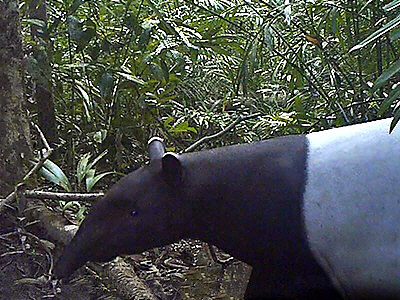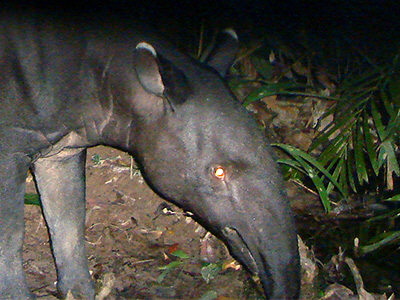
Fig 1

Fig 2
 |
Order : PERISSODACTYLA
Family : Tapiridae
Species : Tapirus indicus
Shoulder height : 90 to 105 cm
Head-body length : 2.0 to 2.4 metres
Weight : typically up to 350 kg
This page is dedicated to the late
Ms. Ong Kiem Sian, a pioneer wildlife photographer from Singapore who once
encountered an Asian Tapir in broad daylight (Fig. 3).
The Asian Tapir, or
Malayan Tapir, is the only member of the tapir family in Southeast Asia, and
is the largest of its kind. All other species of tapir occur in Central and
South America.
This mainly solitary species inhabits undisturbed, moist, lowland
rainforest. Where such habitat has been fragmented by roads or plantations,
it may sometimes be observed moving from one forest patch to another,
particularly at night. In some locations the species is also recorded in
montane habitat up to 2000 metres.
This is a large animal, typically weighing up to 350 kg, though some
specimens may be even larger. Females tend to be larger than males. It is
herbivorous, feeding on forest floor vegetation, including fallen fruit, and
is often active along forest streams where patches of sunlight allow a
greater profusion of vegetation to grow and there is an ample supply of
water. Typically it is nocturnal, but it may remain active into the early
morning.
It has an elongated nose, a bulky body and a short tail. It has small eyes,
and its eyesight is poor and it thus relies mainly on its sense of hearing and smell to
navigate the forest. Its feet are large, with four toes on the front feet,
and three toes on the hind feet.
Its distinctive patterning is quite unique, comprising a black head, neck,
shoulders, legs and hind quarters, which sharply contrast with the middle
part of the body which is white. This colour scheme helps to break up the
animal's outline. Conversely, infants are brownish, with lighter stripes and
spots which also helps to camouflage the animal in sun-dappled forest.
It is not clear to what extent tapir are predated upon by Tiger and
Leopard.
The Asian Tapir, which is considered to be endangered, occurs in southern
Myanmar, southern Thailand, Peninsular Malaysia and Sumatra.
The species has a tenuous foothold
in the Republic Of Singapore, at the extreme tip of the Malay Peninsula. It
is categorised as a 'visitor', which occasionally swims to the republic from
southern Peninsular Malaysia (Chua et al, 2024), landing on the shores of the islands
of Ubin and Tekong, as well as the coast of Changi.
Figs 1 and 2 : Adults traversing a shallow stream
through freshwater swamp forest.
Fig 3 : Asian Tapir traversing an area of logged forest south of Jemaluang,
Johor, Peninsular Malaysia. Image taken by the late Ong Kiem Sian in July
1997.
Fig 4 : Typical lowland, primary forest, which is the
preferred habitat of the Asian Tapir.
Fig 5 : Footprint, measuring 15 cm across, in loosely compacted sand -
this is the front foot, which bears four toes.
Fig 6 : A road sign adjacent to an oil palm plantation depicts a tapir and reads "Caution - wildlife crossing point".
Tapirs cannot survive in areas like this, but are sometimes forced to
transit oil palm plantations where the original forest habitat is
fragmented.
References :
Chua MAH, Thomas N, Teo RCH & Lim HC (2024) Biodiversity Record: Malayan
tapir on Pulau Ubin. Nature in Singapore, 17: e2024118.
Francis, C.M. 2019. A Field Guide to the Mammals of South-east Asia. Second Edition. New Holland. 416 pp.
Lekagul, B., McNeely, J., 1977. Mammals of Thailand. Association for the
Conservation of Wildlife, Thailand. 758 pp.
McCann,
G. E. (2018). Malayan Tapir Tapirus indicus in Hadabuan Hills, North
Sumatra Province, Indonesia. Southeast Asia Vertebrate Records. 2018 : 20-21.
[pdf]
Traeholt, C., Novarino, W., bin Saaban, S., Shwe, N.M., Lynam, A.,
Zainuddin, Z., Simpson, B. & bin Mohd, S. 2016. Tapirus indicus. The
IUCN Red List of Threatened Species 2016: e.T21472A45173636.
Links :
Tapir Specialist Group
Malayan Tapir
Conservation Project
|